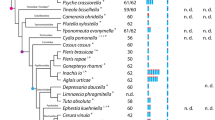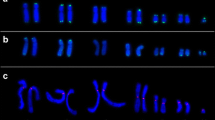Abstract
Genomic organization and chromosomal localization of a previously uncharacterizedD (Donor) locus inXiphophorus andPoecilia species was investigated using fluorescence in situ hybridization (FISH) and Southern blot analysis. Part of this region is thought to be involved in the recombination event leading to formation of theXmrk oncogene and it has recently been shown that this locus included two different genes, one with high homology to a zinc finger protein of the Krüppel type, and the other an unknown gene with high similarity to aCaenorhabditis elegans gene. FISH toXiphophorus chromosomes revealed that these two unrelated genes are closely linked and clustered at a unique chromosomal site. Southern blot hybridization patterns suggest that these genes exist in the genome as multiple copies. Furthermore, similar genomic organization profiles seem to prevail among other related fish. In particular, our FISH experiments reveal the existence of a conserved homologous chromosomal segment harboring the zinc finger protein sequence in several poeciliid fish.
Similar content being viewed by others
References
Adam D, Mäueler W, Schartl M (1991) Transcriptional activation of the melanoma inducingXmrk oncogene inXiphophorus. Oncogene 6:73–80
Adam D, Dimitrijevic N, Schartl M (1993) Tumor suppression inXiphophorus by an accidentally acquired promoter. Science 259:816–819
Ashworth A, Williams BP, Buchberg AM, Goodfellow PN, Solomon E, Potter J, Willison KR (1989) Chromosomal localization of zinc finger protein genes in mouse and man. Genomics 4:323–327
Bellefroid EJ, Lecocq PJ, Benhida A, Poncelet DA, Belayew A, Martial JA (1989) The human genome contains hundreds of genes coding for finger proteins of theKrüppel type. DNA 8:377–387
Bellefroid EJ, Poncelet DA, Lecocq PJ, Revelant O, Martial JA (1991) The evolutionarily conserved Krüppel-associated box domain defines a subfamily of eukaryotic multifingered proteins. Proc Natl Acad Sci USA 88:3608–3612
Bellefroid EJ, Marine J-C, Ried T, Lecocq PJ, Riviére M, Amemiya C, Poncelet DA, Coulie PG, de Jong P, Szpirer C, Ward DC, Martial JA (1993) Clustered organization of homologous KRAB zinc-finger genes with enhanced expression in human T lymphoid cells. EMBO J 12:1363–1374
Bray P, Theisen H-J (1990) Putting the finger on DNA. New Biol 2:325–327
De Robertis EM, Oliver G, Wright CVE (1990) Homeobox genes and the vertebrate body plan. Sci Am 263:26–32
Dressler GR, Gruss P (1988) Do multigene families regulate vertebrate development? Trends Genet 4:214–219
Feinberg AP, Vogelstein B (1983) A technique for radiolabeling DNA restriction endonuclease fragments to high specific activity. Anal Biochem 132:6–13
Förnzler D, Altschmied J, Nanda I, Kolb R, Baudler M, Schmid M, Schartl M (1996) TheXmrk oncogene promoter is derived from a novel amplified locus of unusual organization. Genome Res 6:102–113
Gessler M, Poustka A, Cavenee W, Neve RL, Orkin SH, Bruns GAP (1990) Homozygous deletion in Wilms tumors of a zincfinger gene identified by chromosome jumping. Nature 343:774–778
Haaf T, Schmid M (1984) An early stage of ZW/ZZ sex chromosome differentiation inPoecilia sphenops var.melanistica (Poeciliidae, Cyprinodontiformes). Chromosoma 89:37–41
Hoovers JMN, Mannens M, John R, Bliek J, Van Heyningen V, Porteous DJ, Leschot NJ, Westerveld A, Little PFR (1992) High resolution localization of 69 potential human zinc finger protein genes: a number are clustered. Genomics 12:254–263
Huebner K, Druck T, Croce CM, Thiesen H-J (1991) Twenty-seven nonoverlapping zinc finger cDNAs from human T cells map to nine different chromosomes with apparent clustering. Am J Hum Genet 48:726–740
Kallman KD (1975) The platyfish,Xiphophorus maculatus. In: King RC (ed) Vertebrates of genetic interest. Plenum Press, New York, pp 81–132
Lichter P, Cremer T, Borden J, Manuelidis L, Ward DC (1988) Delineation of individual human chromosomes in metaphase and interphase cells by in situ suppression hybridization using recombinant DNA libraries. Hum Genet 80:224–234
Lichter P, Bray P, Ried T, Dawid IB, Ward DC (1992) Clustering of C2−H2 zinc finger motif sequences within telomeric and fragile site regions of human chromosomes. Genomics 13: 999–1007
Malitschek B, Förnzler D, Schartl M (1995) Melanoma formation inXiphophorus: a model system for the role of receptor tyrosine kinases in tumorigenesis. BioEssays 17:1017–1023
Morizot DC, Slaugenhaupt SA, Kallman KD, Chakravarti A (1991) Genetic linkage map of fishes of the genusXiphophorus (Teleostei: Poeciliidae). Genetics 127:399–410
Nanda I, Schartl M, Feichtinger W, Schlupp I, Parzefall J, Schmid M (1995) Chromosomal evidence for laboratory synthesis of a triploid hybrid between the gynogenetic teleostPoecilia formosa and its host species. J Fish Biol 47:619–623
Schartl A, Malitschek B, Kazianis S, Borowsky R, Schartl M (1995) Spontaneous melanoma formation in non-hybridXiphophorus. Cancer Res 55:159–165
Schartl M (1990) Homology of melanoma-inducing loci in the genusXiphophorus. Genetics 126:1083–1091
Schartl M (1995) Platyfish and swordtails: a genetic system for the analysis of molecular mechanisms in tumor formation. Trends Genet 11:185–189
Schartl M, Wilde B, Schlupp I, Parzefall J (1996) Evolutionary origin of a parthenoform, the amazon mollyP. formosa, on the basis of molecular genealogy. Evolution 49:827–835
Schuh R, Aicher W, Gaul U, Côté S, Preiss A, Maier D, Seifert E, Nauber U, Schröder C, Kemler R, Jäckle H (1986) A conserved family of nuclear proteins containing structural elements of the finger protein encoded byKrüppel, aDrosophila segmentation gene. Cell 47:1025–1032
Simeone A, Acampora D, Arcioni L, Andrews PW, Boncinelli E, Mavilio F (1990) Sequential activation ofHOX2 homeobox genes by retinoic acid in human embryonal carcinoma cells. Nature 346:763–766
Tautz D, Lehman R, Schnurch H, Schuh R, Seifert E, Kienlin A, Jones K, Jäckle H (1987) Finger protein of novel structure encoded byhunchback, a second member of the gap class ofDrosophila segmentation genes. Nature 327:383–389
Villa A, Patrosso C, Biunno I, Frattini A, Repetto M, Mostardini M, Evans G, Susani L, Strina D, Redolfi E, Lazzari B, Pellegrini M, Vezzoni P (1992) Isolation of a zinc finger motif (ZNF75) mapping on chromosome Xq26. Genomics 13:1231–1236
Wittbrodt J, Adam D, Malitschek B, Maüeler W, Raulf F, Telling A, Robertson SM, Schartl M (1989) Novel putative-receptor tyrosine kinase encoded by the melanoma-inducingTu locus inXiphophorus. Nature 341:415–421
Woolcock BW, Schmidt BM, Kallman KD, Vielkind JR (1994) Differences in transcription and promoters ofXmrk-1 andXmrk-2 genes suggest a role forXmrk-2 in pigment pattern development in the platyfish,Xiphophorus maculatus. Cell Growth Differ 5:575–583
Author information
Authors and Affiliations
Additional information
Dedicated to Professor Dr. Jörg Schmidtke on the occasion of his 50th birthday
Edited by: E.R. Schmidt
Rights and permissions
About this article
Cite this article
Nanda, I., Weis, S., Förnzler, D. et al. Clustered organization and conservation of theXiphophorus maculatus D locus, which includes two distinct gene sequences. Chromosoma 105, 242–249 (1996). https://doi.org/10.1007/BF02528773
Received:
Revised:
Accepted:
Issue Date:
DOI: https://doi.org/10.1007/BF02528773




